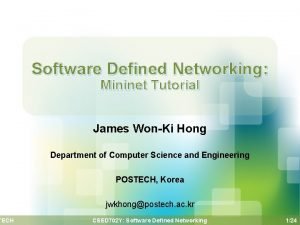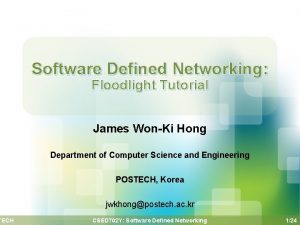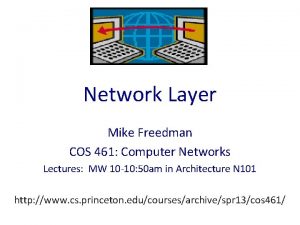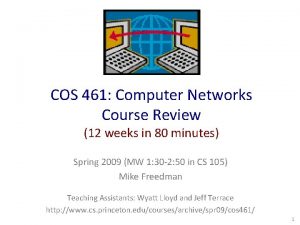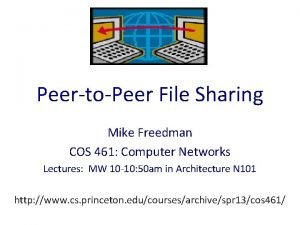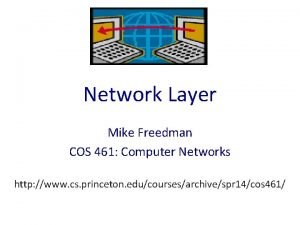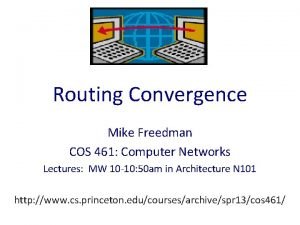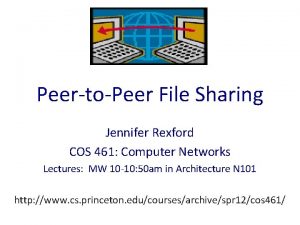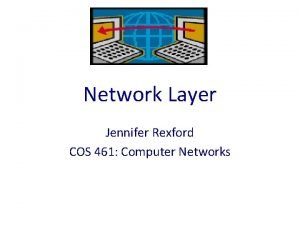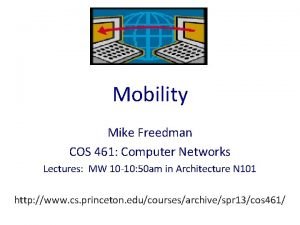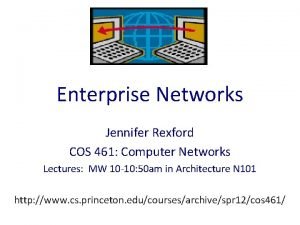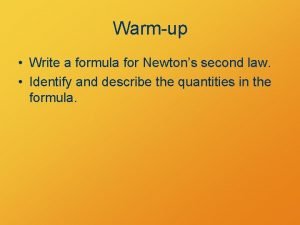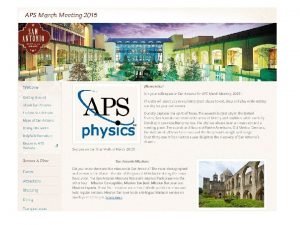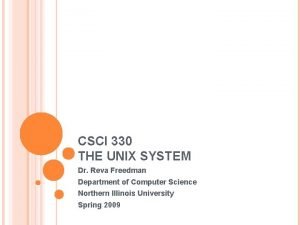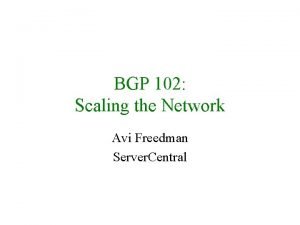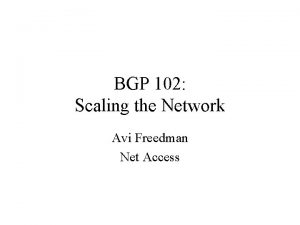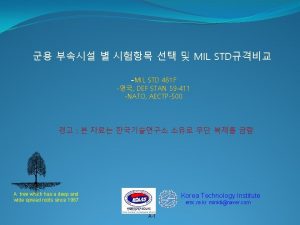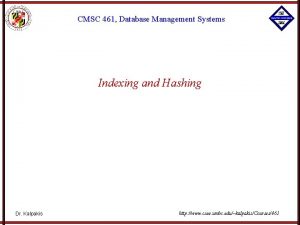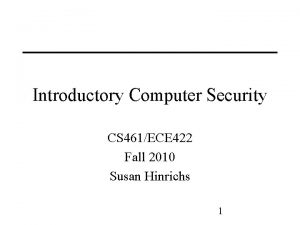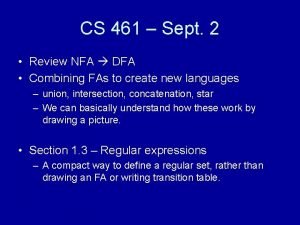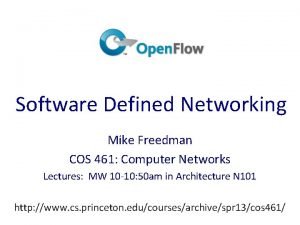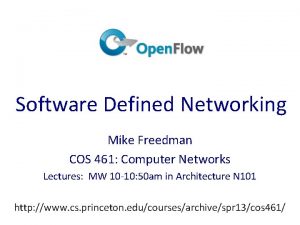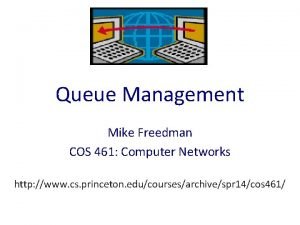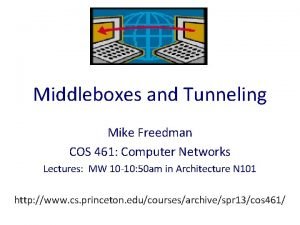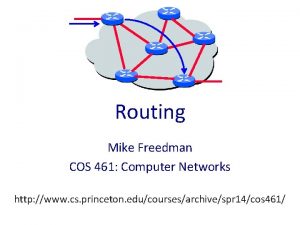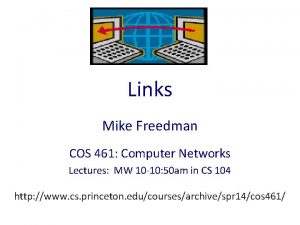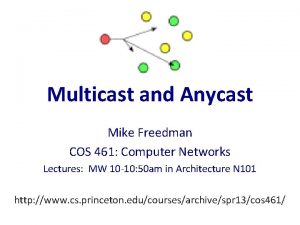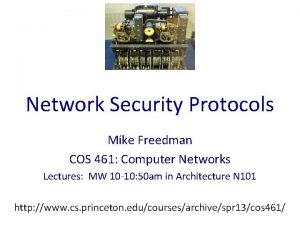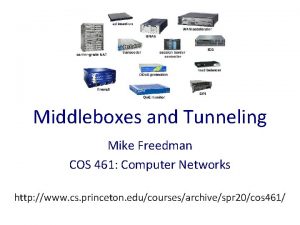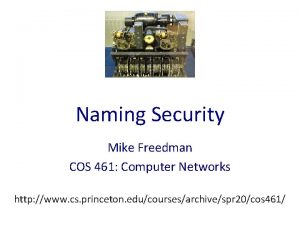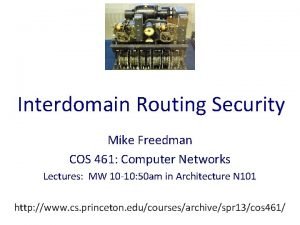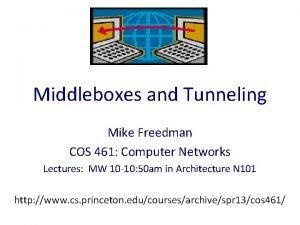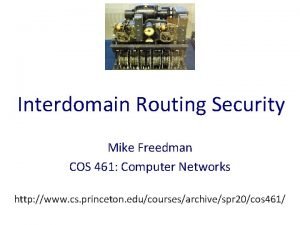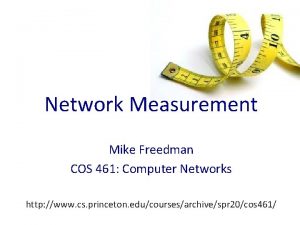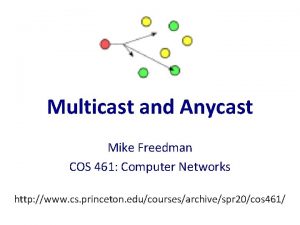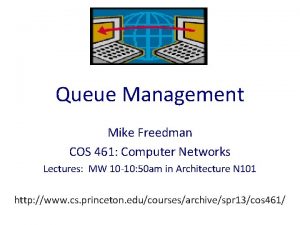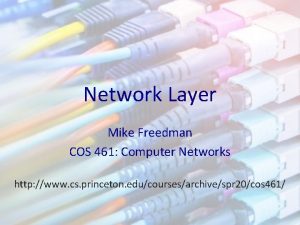Software Defined Networking Mike Freedman COS 461 Computer
































- Slides: 32

Software Defined Networking Mike Freedman COS 461: Computer Networks Lectures: MW 10 -10: 50 am in Architecture N 101 http: //www. cs. princeton. edu/courses/archive/spr 13/cos 461/

2 The Internet: A Remarkable Story • Tremendous success – From research experiment to global infrastructure • Brilliance of under-specifying – Network: best-effort packet delivery – Hosts: arbitrary applications • Enables innovation in applications – Web, P 2 P, Vo. IP, social networks, virtual worlds • But, change is easy only at the edge…

3 Inside the ‘Net: A Different Story… • Closed equipment – Software bundled with hardware – Vendor-specific interfaces • Over specified – Slow protocol standardization • Few people can innovate – Equipment vendors write the code – Long delays to introduce new features Impacts performance, security, reliability, cost…

4 Networks are Hard to Manage • Operating a network is expensive – More than half the cost of a network – Yet, operator error causes most outages • Bugdy software in the equipment – Routers with 20+ million lines of code – Cascading failures, vulnerabilitiesf, etc. • The network is “in the way” – Especially in data centers and the home

6 Rethinking the “Division of Labor”

7 Traditional Computer Networks Data plane: Packet streaming Forward, filter, buffer, mark, rate-limit, and measure packets

8 Traditional Computer Networks Control plane: Distributed algorithms Track topology changes, compute routes, install forwarding rules

9 Traditional Computer Networks Management plane: Human time scale Collect measurements and configure the equipment

10 Death to the Control Plane!� • Simpler management – No need to “invert” control-plane operations • Faster pace of innovation – Less dependence on vendors and standards • Easier interoperability – Compatibility only in “wire” protocols� • Simpler, cheaper equipment – Minimal software

11 Software Defined Networking (SDN) Logically-centralized control Smart & slow API to the data plane (e. g. , Open. Flow) Dumb & fast Switches

12 Open. Flow Networks

13 Data-Plane: Simple Packet Handling • Simple packet-handling rules – – Pattern: match packet header bits Actions: drop, forward, modify, send to controller Priority: disambiguate overlapping patterns Counters: #bytes and #packets 1. src=1. 2. *. *, dest=3. 4. 5. * drop 2. src = *. *, dest=3. 4. *. * forward(2) 3. src=10. 1. 2. 3, dest=*. * send to controller

14 Unifies Different Kinds of Boxes • Router – Match: longest destination IP prefix – Action: forward out a link • Switch – Match: dest MAC address – Action: forward or flood • Firewall – Match: IP addresses and TCP /UDP port numbers – Action: permit or deny • NAT – Match: IP address and port – Action: rewrite addr and port

15 Controller: Programmability Controller Application Network OS Events from switches Topology changes, Traffic statistics, Arriving packets Commands to switches (Un)install rules, Query statistics, Send packets

16 Open. Flow questions • Open. Flow designed for (A) Inter-domain management (between) (B) Intra-domain management (within) • Open. Flow API to switches open up the (A) RIB (B) FIB • Open. Flow FIB match based on (A) Exact match (e. g. , MAC addresses) (B) Longest prefix (e. g. , IP addresses) (C) It’s complicated

17 Example Open. Flow Applications • • Dynamic access control Seamless mobility/migration Server load balancing Network virtualization Using multiple wireless access points Energy-efficient networking Adaptive traffic monitoring Denial-of-Service attack detection See http: //www. openflow. org/videos/

18 E. g. : Dynamic Access Control • Inspect first packet of a connection • Consult the access control policy • Install rules to block or route traffic

19 E. g. : Seamless Mobility/Migration • See host send traffic at new location • Modify rules to reroute the traffic

20 E. g. : Server Load Balancing • Pre-install load-balancing policy • Split traffic based on source IP src=0* src=1*

21 E. g. : Network Virtualization Controller #1 Controller #2 Controller #3 Partition the space of packet headers

22 Controller and the FIB • Forwarding rules should be added (A) Proactively (B) Reactively (e. g. , with controller getting first packet) (C) Depends on application

23 Open. Flow in the Wild • Open Networking Foundation – Google, Facebook, Microsoft, Yahoo, Verizon, Deutsche Telekom, and many other companies • Commercial Open. Flow switches – Intel, HP, NEC, Quanta, Dell, IBM, Juniper, … • Network operating systems – NOX, Beacon, Floodlight, Nettle, ONIX, POX, Frenetic • Network deployments – Eight campuses, and two research backbone networks – Commercial deployments (e. g. , Google backbone)

24 A Helpful Analogy From Nick Mc. Keown’s talk “Making SDN Work” at the Open Networking Summit, April 2012

25 Mainframes App Specialized Applications Specialized Operating System Specialized Hardware Vertically integrated Closed, proprietary Slow innovation Small industry Open Interface Windows (OS) or Linux or Open Interface Microprocessor Horizontal Open interfaces Rapid innovation Huge industry Mac OS

26 Routers/Switches App Specialized Features Specialized Control Plane Specialized Hardware Vertically integrated Closed, proprietary Slow innovation Open Interface Control or Plane Open Interface Merchant Switching Chips Horizontal Open interfaces Rapid innovation

27 Challenges

28 Heterogeneous Switches • • Number of packet-handling rules Range of matches and actions Multi-stage pipeline of packet processing Offload some control-plane functionality (? ) access control MAC look-up IP look-up

29 Controller Delay and Overhead • Controller is much slower the switch • Processing packets leads to delay and overhead • Need to keep most packets in the “fast path” packets

30 Distributed Controller Application For scalability and reliability Controller Application Partition and replicate state Network OS

31 Testing and Debugging • Open. Flow makes programming possible – Network-wide view at controller – Direct control over data plane • Plenty of room for bugs – Still a complex, distributed system • Need for testing techniques – Controller applications – Controller and switches – Rules installed in the switches

32 Programming Abstractions • Controller APIs are low-level – Thin veneer on the underlying hardware • Need better languages Controller – Composition of modules – Managing concurrency – Querying network state – Network-wide abstractions • Ongoing at Princeton – http: //www. frenetic-lang. org/ Switches

33 Conclusion • Rethinking networking – Open interfaces to the data plane – Separation of control and data – Leveraging techniques from distributed systems • Significant momentum – In both research and industry • Next time – Closing lecture – No precept this week
 Sdn architecture vs traditional network
Sdn architecture vs traditional network Data plane control plane and management plane
Data plane control plane and management plane Mininet sdn tutorial
Mininet sdn tutorial Floodlight tutorial
Floodlight tutorial Software defined networking python
Software defined networking python Cos 461
Cos 461 Cos 461
Cos 461 Cos 461
Cos 461 Cos 461
Cos 461 Cos 461
Cos 461 Cos 461
Cos 461 Cos 461
Cos 461 Cos 461
Cos 461 Precidr
Precidr Cos 461
Cos 461 Puwifi
Puwifi Collection of well-defined objects
Collection of well-defined objects Young and freedman
Young and freedman Current resistance and electromotive force
Current resistance and electromotive force Sears zemansky
Sears zemansky Danielle freedman
Danielle freedman Rabbi david freedman
Rabbi david freedman Neil freedman
Neil freedman Steve freedman
Steve freedman Jerome freedman
Jerome freedman Reva freedman
Reva freedman Avi freedman
Avi freedman Avi freedman net worth
Avi freedman net worth Mil-std-461 re102
Mil-std-461 re102 Cmsc 461
Cmsc 461 Dan kamisky
Dan kamisky Cs 461
Cs 461 Ccna voice 640-461 pdf
Ccna voice 640-461 pdf


